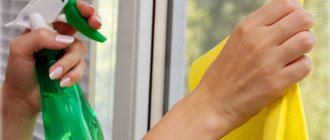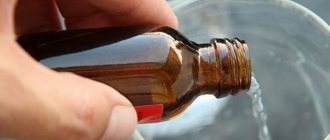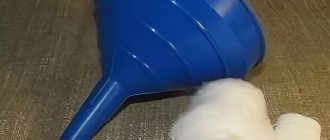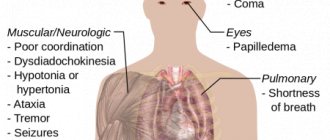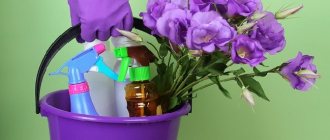Ammonia is an aqueous solution of ammonia. Ammonia // Great Russian Encyclopedia. Electronic version . It is sold in pharmacies, usually in a concentration of 10%. Like baking soda, it can become an indispensable household assistant. Just before use you need to remember a few rules:
- Never mix ammonia (or any product containing ammonia) with bleach. They react and form toxic fumes. If you are going to combine ammonia with a ready-made cleaning product, be sure to check that the composition does not contain chlorine.
- Ammonia causes irritation to mucous membranes and skin. When working with it, wear rubber gloves and ventilate the room well.
- If ammonia gets into your eyes, rinse them with plenty of cold water. If you notice problems with your vision after this, consult your doctor immediately.
Treat stains on clothes
Mix 150 ml of ammonia, 150 ml of dishwashing detergent, 6 tablespoons of soda and 2 cups of warm water. Apply the mixture to the stain and leave for half an hour, and then wash the item as usual. For stubborn stains, such as blood or grass, you can use a mixture of alcohol and water in a 1:1 ratio.
This method will help deal with stains on cotton and polyester fabric. But you can’t use ammonia on wool and silk, these fabrics are too delicate.
Whitening
In addition to removing stains, ammonia is used in everyday life to return things to their original boiling white color, and it also copes with this task with a bang. True, it does not work as well alone as with an assistant in the form of hydrogen peroxide, so stock up on both products. We will soak children's tights, your work blouse and even tulle, yellowed from the sun, in the same solution: add 50 ml of peroxide and 25 ml of ammonia to 4-5 liters of hot water (about 70 ˚C), and soak things in it for several hours and then rinse thoroughly. It is worth noting that this procedure does not replace washing and should be carried out on items that have already been cleaned of heavy soiling.
Advice
White clothes that have become the victim of a bright sock accidentally falling into the washing machine can also be saved with the help of such soaking, if, of course, the colored fabric has not faded too much.
Removing fly marks from glass
Traces of flies on glass are inevitable in the summer. These could be windows in an apartment, your own home or in a car, as well as mirrors, glass tables and other surfaces on which these insects like to sit. Every car trip ends with black spots along the entire perimeter of the windshield and headlights. If the stains are old, it takes a lot of effort to remove them.
If you mix 1 part alcohol and 10 parts water and wash the glass surface with this solution, the marks will quickly be removed. There will also be no streaks or other stains on them.
Overdose
Inhalation of ammonia in large quantities causes a decrease in heart rate , as well as a reflex cessation of breathing .
If the drug is taken orally in large quantities, abdominal pain, diarrhea , vomiting with the smell of ammonia, agitation, and convulsions . In case of inhalation overdose - runny nose , cough , respiratory arrest , laryngeal edema . When used externally in large doses, burns .
Clean leather products
In order to clean and restore the original appearance of tarnished leather products - wallets, gloves, belts, bags, shoes - it is recommended to treat them with the following solution:
- Dilute 20 ml of ammonia and 10 grams of grated laundry soap in 150 ml of water. Wipe the skin with this mixture and dry with a towel.
- To add shine, treat the leather accessory with cotton wool soaked in castor oil, glycerin or petroleum jelly. This procedure can be done when the skin is dry after cleansing naturally.
Pharmacokinetics and pharmacodynamics
Pharmacodynamics
When inhaled, it acts on the receptors of the upper respiratory tract, stimulating the reflex respiratory center. Excitation from receptors along fibers to the central nervous system, where changes occur in the nerve centers, and then in the organs innervated by them. It also has a reflex effect on the functioning of the heart and vascular tone .
When taken orally in small concentrations, it also reflexively excites the vomiting center and causes vomiting .
The “distracting effect” is carried out through cutaneous-visceral reflexes - when applied to the skin, it causes changes in the corresponding segmentally located organs or muscles, which causes restoration of functions. By suppressing the source of excitation that supports the pathological process, it reduces muscle tension and pain, and eliminates vascular spasm .
At the site of application, it irritates skin receptors and therefore causes the release of active substances, as a result of which blood vessels dilate, nutrition and tissue regeneration improve, and an increased outflow of metabolites occurs.
Its disinfectant and antiseptic effect is associated with the ability to coagulate microbial cell proteins in high concentrations. Therefore, you need to remember that with prolonged exposure, the irritating effect can turn into a cauterizing effect, which is accompanied by the development of swelling, hyperemia and pain.
Affects the epithelium of the respiratory tract, activating it and enhancing the secretion of glands. This is manifested by the expectorant effect of the drug.
Pharmacokinetics
It is quickly eliminated by the lungs and bronchial glands.
Some tips
After cleaning, we advise you to go over the linoleum again with a polish based on wax or mastic. Such a coating will protect your linoleum from dust, fading, and accumulation of large amounts of dirt.
Washing your floors this way will also help you get rid of cockroaches. The fact is that these insects do not digest the smell of ammonia and try to immediately leave the room whose surfaces are saturated with it. The only disadvantage of ammonia is its pungent odor. But if you ventilate the room well after cleaning, you can easily get rid of it!
AlinaAuthor of the article
Did you like the article?
Share with your friends:
Fertilizer
It is difficult to believe that a substance with such a pungent odor, and even alcohol, can be beneficial for plants, but with some species this is indeed the case. True, it is added in small quantities so as not to harm the seedlings. Gardeners say that this way it grows stronger and stronger.
If we have missed some way of using ammonia in everyday life, it is only because there are really a lot of them: hurry to take advantage of the versatility of this product for the sake of cleanliness in your home and more.
The role of ammonium hydroxide in biological systems
This substance is an important source of nitrogen for living systems. Nitrogen is a chemical element necessary for the biosynthesis of amino acids. Ammonium hydroxide is used in industry to produce nitrogenous fertilizers necessary for the normal growth and development of agricultural crops.
In human and animal tissues, a significant amount of amino acids is formed due to metabolism. High concentrations of ammonia in tissues are toxic to the body. The liver converts ammonium hydroxide into a product less toxic to the body - urea. Diseases that result in liver dysfunction (hepatitis, liver cirrhosis, cholecystitis) can lead to an increase in the concentration of the above substance in the blood (hyperammonemia). Ammonia hydroxide takes part in the regulation of acid-base balance in the body.
Surface cleaning
An ammonia solution removes heavy stains from tiles, sinks or ovens no worse than from fabrics, so you can wash your entire apartment with the same solution.
- Ammonia is great for cleaning glass, mirrors and other glass products, such as chandeliers and even glasses. It is good because even in solution it does not leave streaks and adds shine.
- With a solution of ammonia applied to a cotton pad, you can even clean the soleplate of the iron so that it does not leave unsightly stains on clothes.
- A solution of ammonia will remove grease stains from tiles if it is a kitchen apron, traces of hard water if it is a bathroom, and dirt if it is a floor.
- Ammonia copes well with greasy stains, so you can wash the stove and oven with its solution, of course, without turning on the gas: it is still alcohol.
We recommend: The best remedy for moths: not a single individual will survive!
Disinfection
For the same tiles, treating with ammonia is not just cleaning, but also the prevention of fungus and mold, which makes the grout between the tiles look simply terrible. Of course, it is better to use regular alcohol to disinfect your hands, but it is quite possible to treat objects with ammonia. For example, hair combs and brushes are soaked in an ammonia solution, which are difficult to properly rinse and disinfect in any other way.
Contraindications for use
You should not use the above pharmaceutical agent in case of loss of consciousness in the absence or difficulty of reflex conductivity from the nasal receptors to the brain. In this case, the miracle of “revival” with ammonia will not happen. In this situation, parenteral administration of other drugs will help. Ammonia water is contraindicated for use in the presence of weeping eczema and dermatitis, since this drug will provoke even greater irritation of the skin and can cause a burn.
Repellent
The use of ammonia in everyday life is not limited to the area of cleaning: it can also serve in the fight against insects that have decided to settle in your apartment. Brown ants, which are often simply impossible to remove using traditional methods, will forget the way to your kitchen if they smell ammonia. You can also take it with you on outings: it works no worse than factory repellents, and costs much less.
Advice
If you apply a tiny amount of ammonia to an insect bite, it will stop itching.
Beauty product Ammonia has interesting properties for dry and problematic skin of the feet. If you add literally a couple of drops of this product to the baths, the skin softens, cracks heal faster, the unpleasant odor recedes, and the roughening of the skin occurs more slowly.
Important!
Ammonia is used in small quantities orally to induce vomiting in case of poisoning, but it is better not to use it outside medical institutions for such purposes: a slight overdose and you will get a burn to the mucous membranes and serious poisoning.
Why do you need ammonia in the garden?
In the garden, ammonia is not only a fertilizer and top dressing, but also an excellent pest repellent.
Dilute 50 ml of ammonium hydroxide in 4 liters of water and fly your shrubs to the roots. This will not only increase fertility, but also protect the roots from mole crickets. If you spray the leaves, you can fight aphids. For indoor flowers, the use is similar, but you should slightly reduce the dose.
Returning the color of carpets and furniture
There are many different store-bought products available for cleaning carpets and furniture that create a lot of foam. The whole action becomes troublesome and time-consuming, and sometimes harmful to furniture and carpeting.
Ammonia will cope much better with dirt. First, the carpet or furniture needs to be vacuumed to get rid of accumulated debris and dust.
Then mix 3 tablespoons of alcohol with 1 liter of water. A sponge soaked in this mixture can be used to wipe carpets and upholstered furniture. Some housewives wait five hours and vacuum the surfaces being cleaned again.
Other life hacks
What else can be quickly and safely cleaned with ammonia:
- Greasy clothes. Mix 25 g of salt and 5 ml of alcohol. Apply to fabric, wait 15 minutes and wash as usual.
- Perfume stains. Mix water and ammonia 1:1, blot the stain and wash after 15 minutes.
- An aqueous solution of ammonia 5:1 cleans mirrors, chandeliers, vases.
- The same composition can be used to wash tiled surfaces in the kitchen and bathroom. Ammonia provides a disinfecting effect.
- Using a cotton pad soaked in ammonia, occasionally wipe the soleplate of the iron. The device will stay clean longer.
Our mothers and grandmothers actively used ammonia, and the houses were always clean and comfortable. Today, the variety of household products has pushed such life hacks into the background. I advise you not to forget the traditions of your ancestors: this greatly saves the family budget.
What to do in case of ammonia vapor poisoning?
First aid for ammonia intoxication: ensure maximum flow of fresh air into the room (open the window); perform repeated gastric lavage; give the victim a spoonful of vegetable oil, a few egg whites, a glass of milk; If possible, do a cleansing enema. If undiluted ammonia water gets on the skin, the victim will also need qualified assistance. In this case, the main therapeutic assistance is abundant rinsing of the affected areas with water for 10-15 minutes. The use of any ointments within 24 hours is contraindicated. In the future, the therapeutic regimen is the same as for thermal burns. If ammonia water splashes into your eyes, you should immediately rinse your eyes with running water, then apply olive or petroleum jelly, sodium sulfacyl, novocaine with adrenaline. In case of laryngeal spasm, local heat, inhalation, atropine are prescribed, and, if necessary, tracheotomy. If necessary, artificial respiration should be performed.
Elimination of odors
Another useful tip for using ammonia in everyday life is eliminating ingrained unpleasant odors in the room. If you place small containers of ammonia around the room, then after a while the smell will go away, and although the ammonia will have to ventilate the apartment for a long time and thoroughly, soon there will be no odors in it except the smell of cleanliness.
We recommend: Is it possible to degrease with white spirit - using the solvent at home
Instructions for use
To revive a person who has fainted, you need to pour a little ammonia solution onto a cotton swab and bring it to your nose at a distance of 5 cm. Close inhalation of the product is prohibited, because this can cause a burn to the nasal mucosa. If you are bitten by insects, you need to apply lotions. To use the drug to induce vomiting, you should take ammonia in ampoules, pour 10 drops of the product into 100 ml of warm water and give it to the patient to drink orally. For a wet cough, the doctor may prescribe inhalations, but only through a special device.
For windows
A headache for many housewives is stains on window glass. Washing by hand can't compare to the results of modern household appliances, but not everyone can afford them. Washing windows with ammonia will bring the result closer to ideal and save nerves.
How to make a solution and wash windows, instructions:
- For 5 liters of water, 5 ml of ammonia is enough.
- Another option is 200 ml of water + 200 ml of glycerin and 5 ml of ammonia. Why add glycerin? This substance forms an invisible film on the glass, which repels dirt and makes subsequent washing easier.
- The solution is thoroughly mixed. Does not require rinsing.
Don't forget about washing technique. Use glass cleaner with a telescopic handle and lint-free rags. Avoid abrasives. First wash the window sill and frame, and then the window itself, otherwise the washing will take a long time.
